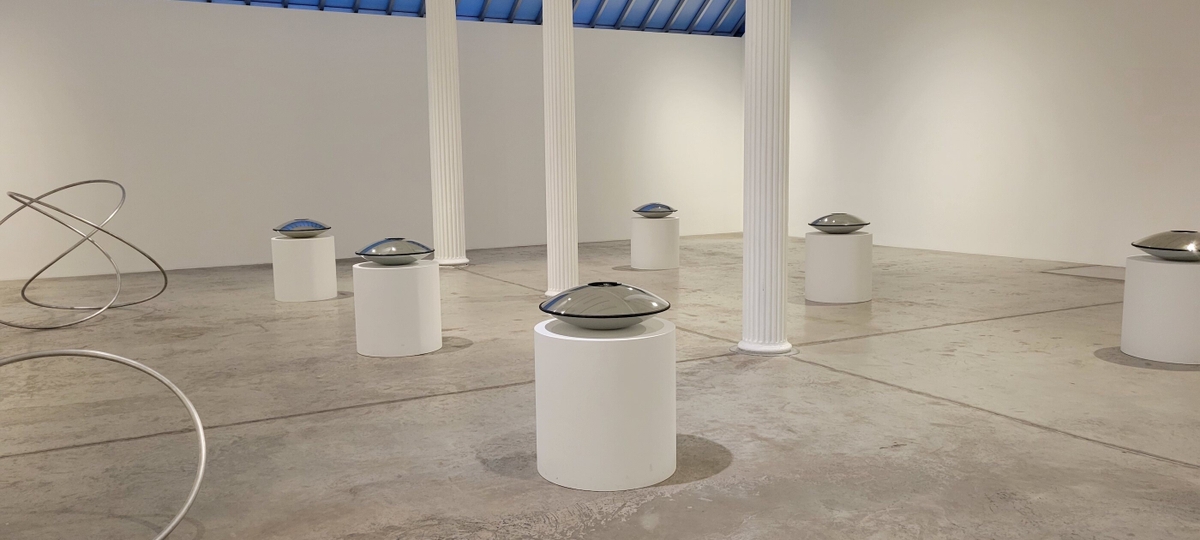NYC
Dancer of Motion and Illusions
by | Mar 1, 2024 3:36 pm
Post a Comment | E-mail the Author
Posted to: Visual Art

Madeline Hollander: Entanglement, Bortolami gallery.
Madeline Hollander: Entanglement
Bortolami
39 Walker
Through March 2
From the Tribeca Bortolami gallery room’s entrance, rows of cylindrical plinths, topped with flying saucer-like disks invite a remarkably unremarkable initial impression. That’s the first visual deception at one of the most surprising exhibitions that I recently visited in New York City.
Come closer.
Peer inside one of the shiny bowls and a metal figure appears to spin in mid-air. Beneath the silver representational person, its solid aluminum counterpart twirls in synchronicity. Each structure contains joined parabolic mirrors and a motorized, rotating base, creating a three-dimensional, holographic, floating dancer. When viewed in sequence, dancer and artist Madeline Hollander’s six cast aluminum figures reveal a choreographed performance of optical illusions.

Madeline Hollander, "Entanglement Choreography III" (glass optical mirrors, cast aluminum, electric turntable, wood pedestal).
Her exhibition Entanglement made me think of how with death comes the total stillness of motion — and disappearance of all illusions. For what is life absent of all motion and our grand illusions?
The stark white room with its contemporary staging provides an ample space for walking. Each of the mirrorscopes contains a version of the same magical trick of artistry. Hollander’s silver-toned figures reminded me of Alberto Giacometti’s rough-hewn sculptures, but not as elongated and neither weary nor exhausted. Instead with animation, they convey life-affirming attitudes. Some have continuously looping arms and legs or are twisted into pretzel-like configurations. They all are on view against vibrant, bright backgrounds with colors like orange, purple, blue, or green.
Gallerygoer Gee Wesley, a co-founder of a nonprofit art bookshop based in Philadelphia, shared his thoughts on the exhibition’s meaning. “Maybe it’s about how we perceive the limits of what we can perceive? You perceive this object protruding out from the surface but it’s actually within the disk,” he said. “There’s a play about reality and boundaries between one thing or another.”
I asked if he felt the artwork’s medium commented on the beautiful, necessary illusions in life, the psychological mirages we humans need to survive?
“So much of our perception of the world can’t be proven or disproven,” said Wesley “Is it all a dream, an illusion even being here?” At that point, we both just shook our heads and laughed.
Madeline Hollander’s Entanglement Choreography. How real are illusions?
The sculptor expressed a more scientific approach to her art, according to a statement provided by the Bortolami gallery. Her art references what Albert Einstein called “spooky action at a distance.” This occurs when “two particles, despite being separated in space and time, act in tandem.” Visitors looking inside the mirrorscope see both the solid, cast aluminum figure at the base and its airborne doppelgänger dancing on another plane.
Visitor Ruby Guralnik Dawes brought her perceptions as a former dancer to the exhibition. The figures in motion resemble how as a dancer your body comes in and out of your view and when interacting with other dancers you connect with their body parts, then disconnect and connect again, she stated.
“You have to be physically moving in the space to understand what the form is. Your body has to interact with the sculpture to understand how the shapes are forming,” said Guralnik Dawes.

Madeline Hollander, "Alice," bent aluminum, 4 ft diameter (2023).
Three bent aluminum sculptures rest at the perimeter of the rectangle of optical illusion devices. These abstract pieces have titles of the names: Bob, Charlie, and Alice. Visitors can nudge them, gently activating their wobbling and rolling motion. What at first seems like a simple curved wire morphs into different shapes based on the moving perspectives of viewers. My walking around the knotted form titled “Alice,” made it move and perform in my eyes, turning me into a live audience member — watching a dancer.
At the exhibition, the tune of “Human” sung by The Killers lead singer Brandon Flowers kept resurfacing in my mind.
Are we human
Or are we dancer?
My sign is vital
My hands are cold
And I’m on my knees
Looking for the answer
Are we human
Or are we dancer?
For the first time, the song’s defiance of grammar and rules made sense. This exhibition, which closes on Saturday, answered the question, with a dancer in the mirrorscope. We are human and we are dancer because our signs are vital.
Listen: Brandon Flowers of The Killers sings "Human."